Solar Power for Cars – From Myths to Reality (What You Need to Know)
Ever seen an EV topped with solar panels?
Me neither! And that’s strange considering that a solar-powered vehicle can run on itself without the need for a recharge. Well, at least in theory.
Surely, EV manufacturers have thought about using the immense power of the sun to charge car batteries. With portable solar panels becoming popular, it makes a lot of sense to use solar panels on cars too. After all, it is free power.
Turns out, there is a lot to understand about the issue before jumping to any conclusions.
So, let’s take a deep dive to unravel the mystery of solar panels (or the lack thereof) for EV cars.
Related Post: Carbon Footprint of Electric Cars (Are They REALLY Green?)
Why Don’t Electric Cars Have Solar Panels?

Actually, the reason is simple.
In fact, the idea of car roof solar panels has been around since the 1960s. But the limited real estate on the surface of vehicles doesn’t allow solar panels to make a significant contribution to battery charging. Let alone drive the car on solar power entirely!
Note that we are not just talking about installing solar panels on the vehicle roof. All available surface areas, including hoods, tailgates, doors, and trunks would be used too. But even with that, the surface area available on a vehicle is not enough.
You may ask, what about the windows?
Well, transparent solar cell technology is yet to advance to that stage to make any significant contribution. They have even lower efficiencies than traditional silicon PV cells. When it comes to solar glass, the right combination of transparency and efficiency is not easy to achieve.
Considering that the average efficiency of top-grade solar panels is around 22%, the best the panels can do is to reduce the charging frequency. Besides, there are other factors like cloudy weather, low sun angles, haze, and dust that will affect the power generating capacity.
One report suggests that solar panels in a typical EV can contribute around 25% of the vehicle’s annual energy needs. While that can reduce 300 kg of CO2 emissions in a year, it is not a practical solution. In terms of economics, or rather a cost-benefit perspective, this does not make it a feasible option for vehicle manufacturers.
Troubles don’t end there.
Keep in mind, the process of attaching solar panels to the surface of a vehicle is not simple. In the words of Peter Harrop, the chairman of IDTechEx, a company that conducts market research about this technology, “To achieve the complex shapes needed for car bodies, thin solar cells must be molded into carbon fiber, glass or polycarbonate sheets. They become less like traditional solar panels because they are actually structural elements.”
To make the picture more clear, let’s consider a simple example.
An average solar panel generates around 2 kilowatt-hours in a day with peak sun hours being around 5 hours per day. The surface area of a typical solar panel is around 17.5 square feet.
Consider a small electric vehicle with a battery size of 40 kWh and a surface area of 60 square feet. Even if we can manage to fix around 3.5 solar panels on the car, it will generate around 7 kilowatt-hours per day in the best conditions. That means it would take almost 6 days to get the battery fully charged.
Compare this with a Nissan Leaf being charged by a high-speed charging station. The 40 kWh lithium-ion battery in the vehicle can get charged in under 2 hours when connected to a Level 2 charging station.
You get the picture. So, it will take some more years for the technology to evolve and produce solar panels that will allow you to run the vehicle just by using the sun.
However, solar panels are more feasible in commercial vehicles like trucks and trailers which have a larger surface area. In reality, the power generated will not be enough to replace the existing power-generating systems. But it can operate the heating and air conditioning, navigation, cameras, radios, and other systems. That will reduce energy requirements and at least increase the charging intervals.
Solar Panels for Cars: Makes & Models Already Using Next-Generation Tech
The good news is, vehicle companies have not given up on the idea of using solar panels on cars and trucks. Generally, the common approach to increase EV range is to add bigger batteries. But high-capacity batteries are expensive. Manufacturers are realizing that by making effective use of solar panels, the vehicle range can be increased.
Considering the fact that we are witnessing the first generation of solar electric cars, there are plenty of exciting and innovative vehicle designs coming up.
Aptera Motors
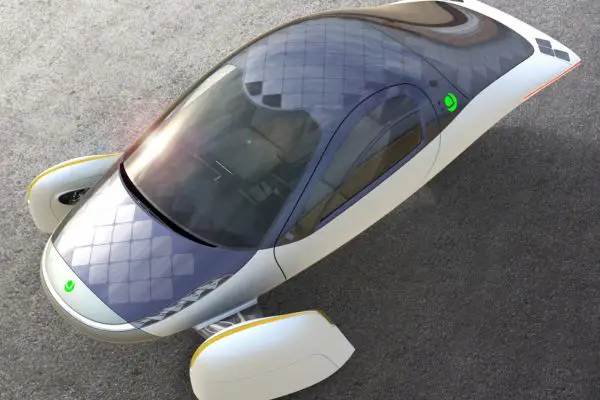
The San Diego-based startup is all set to launch its first solar vehicle. This is a three-wheeled car with a curved nose that resembles an aircraft, and an undercarriage shaped like a “dolphin’s belly.” While I would say it looks weirdly cool, purists may call the design totally bonkers.
With the 100 kWh drive system, the range of the vehicle is 1,000 miles, which blows away all the EVs in the current market. It has 3 square meters of solar array that can generate 700 watts. High-efficiency Maxeon solar cells were used, which adds 40 additional miles per day to the range. If you drive within that range every day, it will extend the time between charging station visits by a significant amount.
Take it from the company: ‘In a location with medium sun exposure such as New York or Chicago, you will only need to plug in roughly three times per year.’
Will they live up to the promise? We won’t have to wait long to see. Aptera has already received 25,000 reservations and production can begin by late 2023. The point is, this is not a car that relies totally on solar power. Rather, the solar panels are working as battery life extenders.
The Lightyear Solar Car
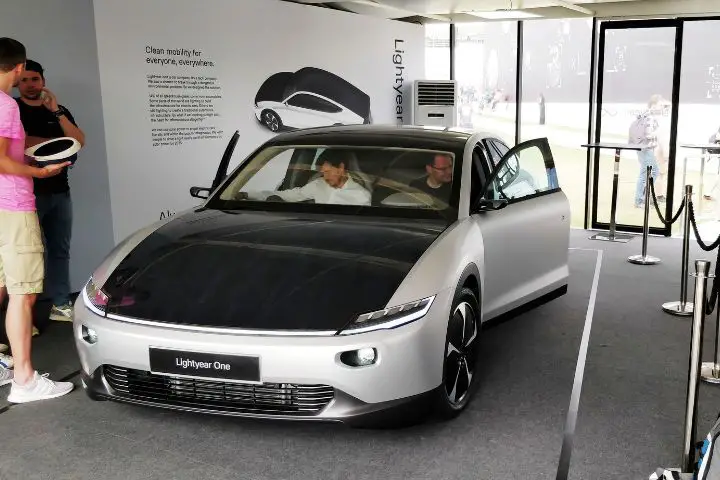
In 2021, solar-electric vehicle maker Lightyear revealed a prototype, the Lightyear One – a vehicle capable of charging itself using the sun. The finished product was Lightyear 0, and it had 54 square feet of solar array spread on the car body, along with a 60-kWh battery pack. The sleek sedan design is not too bad either.
Lightyear mentions that the solar panels used on the Lightyear 0 are more efficient than panels used in any other vehicle. The Lightyear 0 used 5 square meters of monocrystalline silicon solar cells on the roof and hood of the vehicle. The battery pack itself can provide the car with a range of 450 miles. On top of that, the solar panels will add around 43.5 miles per day when exposed to the sun.
But how much do you have to pay for that advanced piece of technology? The Lightyear 0 came at a whooping $320,000 with VAT. If you ask me, that is a frightful amount of money to gain 43.5 additional miles. That limits the number of buyers to a few handfuls.
It seems Lightyear got the message too. Within two months, the production of the flagship Lightyear 0 was halted. The company is now aiming to launch the Lightyear 2 at a more affordable price bordering around $40,000.
Obviously, the task will be challenging and the initial plans mentioned that the market rollout is expected in late 2025.
Sono Motors
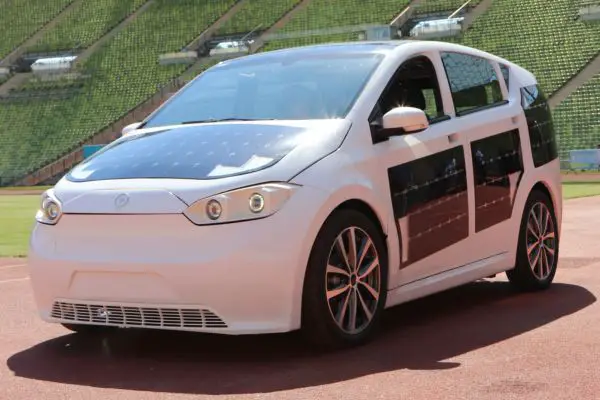
The concept of the affordable Sion solar electric hatchback car was launched back in 2017 with a price of around $26,375. The specs mentioned 456 monocrystalline solar half cells that extended the range of the 54 kWh battery.
Unfortunately, things did not work well for the brand. Sono was plagued by financial drags and pushed to a corner where it came close to shutting down altogether. While it managed to survive, the company shifted to selling its solar technology for third-party vehicles. Quite simply, the Sion project ended up on the ash heap of solar history.
The CEO and co-founder Laurin Hahn explained, “Even though we had to terminate our original passion project, the Sion program, shifting our entire focus to business-to-business solar solutions provides us with an opportunity to continue to create innovative products in the solar space.“
At present, their products include a solar bus kit that allows buses to reduce fuel consumption. Other technologies include solar PV integration solutions for truck fleets and recreational vehicles.
Fisker Ocean
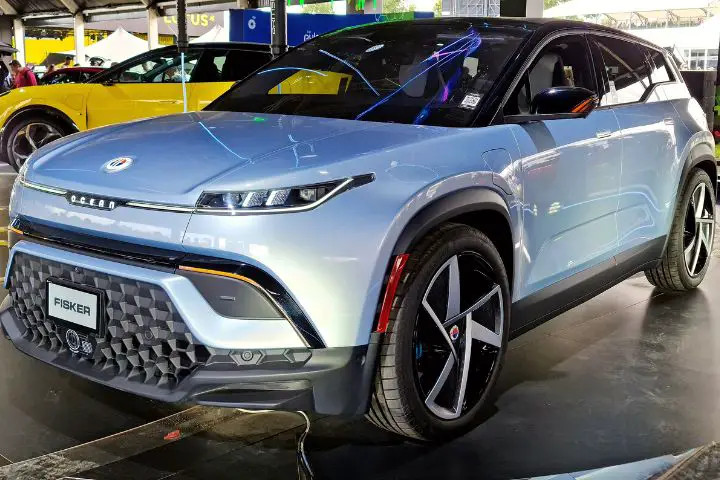
Meet the solar vehicle with a full-length SolarSky roof, that has solar panels to supply additional energy to the car’s motor. In clear and sunny conditions, the roof will add between 1,500 to 2,000 miles to the annual range of the car.
The price of the Fisker Ocean Extreme model with the SolarSky technology will be $68,999. Fisker has developed a new technology to optimize solar power that remains undisclosed.
“It is one thing to show a solar roof, it is another to make it work…I don’t know how other people do it because it is not easy to do and really get all the power in,” CEO Henrik Fisker, a veteran in the automotive world, says in an interview with MotorTrend.
Can you drive the Ocean around with power generated from solar only?
Not really. That might be possible as panel technology develops in the future. But as of now, “We are not there yet,” says Fisker.
The Tianjian
China launched the country’s first pure solar car, the Tianjian, at the World Intelligence Congress in June 2022. Developed by a team from 42 companies and three universities, the car cross-integrated various cutting-edge technical features. The Tianjian carries around 87 square feet of solar panels.
On the brightest days, the output from the panels can be as high as 7.6 kilowatt-hours. The vehicle can carry three passengers and has a top speed of 49 mph or 79.2km/h. The maximum range that the car’s battery can deliver is 47 miles.
Admittedly, the design and the specs are not as thrilling as some of the high-end models on the global market. But let’s not forget, this is the only vehicle that runs solely on solar power. Moreover, it can cut down 25 kgs of carbon emissions for every 100 miles of travel.
The Tianjian is not yet ready for the mass market and is currently on a tour around China to seek more support for further development. According to Ma Chuangguan, a researcher at the Tianjin Municipal Science and Technology Bureau,” We hope that the car will be the spark that brings together enterprises in the automotive and IoV industry chain”.
The World Solar Challenge
No discussion about solar panels for cars is complete without a look at the one and only Bridgestone World Solar Challenge. This is a global racing event where schools and university students drive self-designed solar cars through 3,000 kilometers of the Australian wilderness.
What’s more, some of these vehicles can run as long as 1,000 kilometers without recharging from the grid. Since conditions on this inhospitable terrain are simply grueling, the achievements are remarkable.
To be honest, most of these cars look like space-age vehicles that daily commuters will shy away from. Think about lightweight carbon-fiber chassis, motors with efficiencies as high as 98% and drag coefficients as low as 0.095. However, the goal of the event is to encourage innovative solutions that promote sustainability.
Taka Horio of Bridgestone Motorsport UK which sponsors the event, says, “ The event provides an invaluable opportunity. The Bridgestone World Solar Challenge leads to enhancement of technologies, innovation, and solutions that tackle social and environmental issues.”
Solar Power Charging Station for Electric Cars – The Reality
The idea of charging EVs with solar power in parking spots seems like a win-win situation. Charging EV batteries by using grid-based electricity that is generated from non-renewable sources is not the best solution for reducing carbon emissions.
Modular solar chargers with a canopy of solar panels have been developed for off-grid locations. If needed, it can also be connected to the grid. Such a system will not only reduce carbon emissions but will also bring down charging costs. “Electrify America” has started setting up such charging stations with solar canopies.
But here’s the rub. Direct current fast chargers (DCFC) consume too much power. To power a high-capacity 350-kilowatt charger, more than 1000 solar panels will be needed.
Here’s what a spokesperson for fast charging station network EVGo says about solar charging stations- “In fact, it would take acres of solar and wind to power our fast-charging stations (especially our new 350 kW stations), which would be difficult in the retail parking lots and urban centers where we install chargers.”
Let’s face it. While solar canopies are a step in the right direction, we can’t expect the EV charging process to go completely green anytime soon.
As electric vehicles become more popular, the idea of solar charging from home will gain more traction. Obviously, it’s a much better option than hunting for a public charging station.
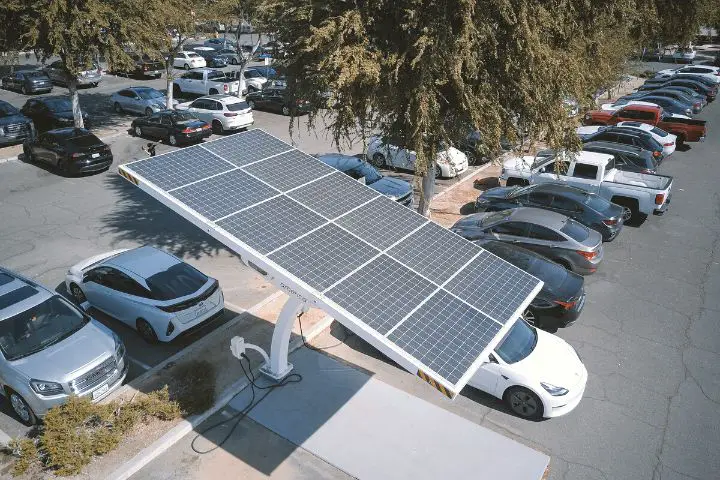
Next question – how long would it take to charge an electric car with a solar panel?
The answer depends on multiple factors like the number of miles you travel in a day and the vehicle’s fuel efficiency rating.
Let’s consider the Tesla Model Y which delivers around 3.8 miles per kWh. If you drive an average of 50 miles in a day, the vehicle will need 13.16 kWh per day (50 miles per day / 3.8 miles per kWh).
Next, we assume the following data.
- You use solar panels with a wattage of 350 Watts
- Your location receives an average of 5 sun hours per day
So the total wattage generated by a panel in a day will be 350 Watts x 5 sun hours = 1750 watts = 1.75 kWh per day.
Dividing the total power consumption of the vehicle by the power generated by the panel will give you the number of panels needed for charging. In this case, 13.15 kWh per day / 1.75 kWh per panel per day = 7.5 panels.
Rounding off, you will need 8 panels that generate 350 watts to charge the Tesla Model Y daily. However, the numbers will vary depending on the available sunlight hours and the number of miles of travel.
Final Thoughts
It all boils down to this. While there are plenty of things we can do as eco-travelers to embrace sustainability, our options while driving around in our electric vehicles are limited.
Even as solar panels get more efficient, you won’t find Teslas with a solar roof anytime soon. When businesses consider the costs of R&D, electronics, and assembly, the cost-benefit horizon is not shiny enough. Quite simply, using the wall charger in your garage makes more sense.
For sure, quite a few brands are trying to use solar panels for cars. And many more will in the coming years. But riding a sleek and shiny vehicle that runs solely on solar power – that’s another story.






